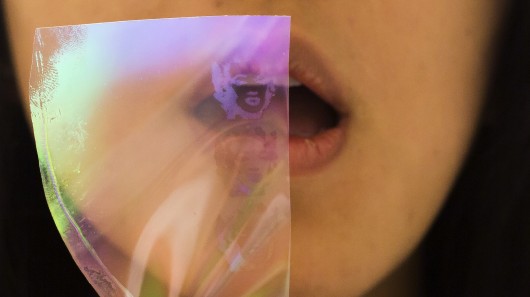
Allowing consumers to identify counterfeit goods is a tricky and expensive problem, as many security measures such as holograms might be easily mimicked by counterfeiters. A new nanoscale printing technique, however, allows researchers to create labels that reveal a "watermarked" image when breathed upon by the consumer. The labels are scalable and durable, and can be applied to many surfaces, yet are beyond the hands of those who might try to mimic them to fool consumers.
 Allowing consumers to identify counterfeit goods is a tricky and expensive problem, as many security measures such as holograms might be easily mimicked by counterfeiters. A new nanoscale printing technique, however, allows researchers to create labels that reveal a "watermarked" image when breathed upon by the consumer. The labels are scalable and durable, and can be applied to many surfaces, yet are beyond the hands of those who might try to mimic them to fool consumers.
Allowing consumers to identify counterfeit goods is a tricky and expensive problem, as many security measures such as holograms might be easily mimicked by counterfeiters. A new nanoscale printing technique, however, allows researchers to create labels that reveal a "watermarked" image when breathed upon by the consumer. The labels are scalable and durable, and can be applied to many surfaces, yet are beyond the hands of those who might try to mimic them to fool consumers.
The research, from the University of Michigan and from South Korea, addresses some prior problems of creating polymer-based nanopillar arrays, or sheets of a material doped with nanometer-scaled towers. Though these materials could be useful in a variety of fields such as wearable electronics or solar cells, their construction has previously been undoable with cheap molding processes, because the material tends to stick to the template of tiny, nanometer-sized holes, rather than sticking to the intended substrate.
However, a new polymer blend of adhesive and a polyurethane not only allows the material to shrink and pull slightly away from the mold, but produces a stronger result that can stick to more types of materials (plastics, fabric, paper, and metal were tested). It also resists being rubbed away, as might
To create the secret hidden image useful for counterfeit prevention, these sheets, currently moldable up to 8 in (20 cm) in diameter, are fed into something similar to an inkjet printer with smaller drops. Wherever the nanopillars are covered or the spaces between pillars are filled in, a hidden image is created. When the material is breathed on, the image appears like magic – in reality, the moisture in the breath condenses in the filled design.
The production method is so cost-effective that the researchers anticipate the molded labels could be produced at about US$1 per square inch, with manufacturers then using the deposition printers, already in use in some industries, to apply their own watermarked logo.

 Previous page
Previous page Back to top
Back to top







